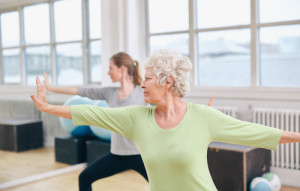Although it comes in many forms throughout the body, in general arthritis is an inflammation. There are various reasons that this condition occurs, but one thing is for sure — it can affect a person of any age and in many different situations. According to the CDC, it disproportionately affects aging populations, but it is also well-documented in children and younger adults as well. It’s likely that many people will either suffer from the disease itself or will know someone close to them who has to live with it.
There are many factors that go into the treatment of arthritis, but one thing is clear, exercise can make a BIG difference in management of the disease.
A Quick Warning
Everyone is unique and has their own specific challenges. You should ALWAYS consult with your physician before engaging in a fitness program of any sort. They will be able to help you to understand which exercises will work for you and which ones you should avoid. Use these exercises as a guide when discussing your exercise plan with your physician.
Are There Benefits to Exercising with Arthritis?
Absolutely. According to the Mayo Clinic, exercise isn’t just a nice thing to do, rather it’s a crucial part of treatment. There many benefits to include increased flexibility, increased strength, more energy and a reduction of joint pain.
Exercise helps diminish many of the underlying factors which exacerbate the condition. When you strengthen the muscles which support your joints, you relieve pressure on them. Gravity affects all of us, and there are two main organ systems which keep us up and on our feet — the muscular system and the skeletal system. When muscles are weak, your body relies more on your bones to support itself.
As such, when you exercise and strengthen those muscles, it relieves pressure on your joints which will result in less pain. Additionally, exercise will likely cause a reduction in body fat and overall weight which will also relieve joint pressure. Furthermore, exercise will give you more energy. This seems a bit counter, as exercise is temporarily tiring, but over the course of the day, you will notice having more endurance and better focus.
So with that in mind, let’s talk about some of the exercises you can do at home that can help you manage treatment and even make some improvements in quality of life.
Yoga
One of the best elements of yoga is its scalability with medical conditions. There is almost always a way to modify the position — or make it simpler and easier to do correctly — for those who have mobility issues. Start simple and start slow. It can also be incredibly helpful to find a local class with a certified instructor who can both observe, teach and assist you as you get used to the movements.
Safety becomes even more critical as you age because injuries require more and more time for recovery as your body gets older. So take it easy and don’t try to do too much in the beginning.
 Walking
Walking
Walking will help you with your endurance, as well as weight control and emotional health. Start with what’s familiar, maybe walking around your house for a certain amount of time. Then, as that takes, expand to your neighborhood. Just make sure you have supportive footwear so as to not make anything worse.
Bodyweight Exercises
Doing bodyweight exercises can be incredibly useful and save you a fortune in gym fees. The body already contains all of what’s needed for a proper workout. The main consideration you might want to take with this, however, is that sometimes, modification is needed.
For instance, if you are pained by or unable to do regular pushups, start with wall pushups. These allow you to train your upper body without putting all of the strain on your elbows that pushups can cause. Steadily, as your body gets used to them, move your feet further away from the wall. This will increase your angle and thus make the exercise a little more difficult.
Another example is with regular bodyweight squats. Start with a slight knee bend that engages your quadricep and hamstring muscles, then go right back up. You don’t have to squat deep to still get the benefits from them. As you practice, you will steadily be able to dip down further and further. Make sure that you have a chair, a wall or some railing to hold onto if you need it. Injury prevention is the name of the game.
Live Your Life
One of the best ways to incorporate exercise into your routine when suffering with arthritis is to get out and enjoy the world. Walk in the park. Sign up for a sunrise yoga class. Try some bodyweight exercises during the next commercial break on TV. There are so many different ways that you can attain the positive benefits of exercise in a way that allows you to enjoy your life.
Ultimately, this is all about living well. Incorporating things that make you happy like friends, entertainment or music into your workout routine will help you stick with it. As always, don’t forget to check with your doctor. They will be glad you asked.
Jane Curth is the co-founder and CEO of FitFixNow. Helping people on their wellness journey is her passion; Jane has helped clients and students with their diet and fitness struggles for over 20 years.


